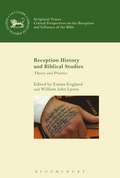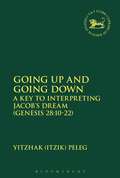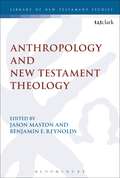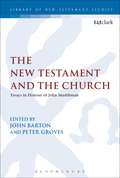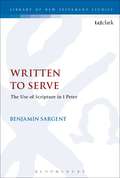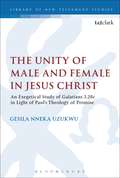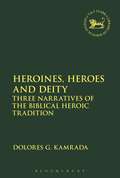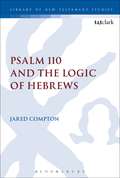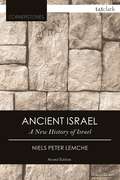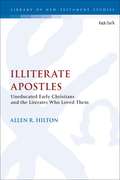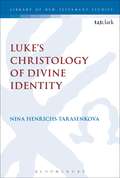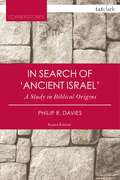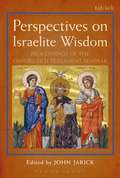- Table View
- List View
Concerning the Nations: Essays on the Oracles Against the Nations in Isaiah, Jeremiah and Ezekiel (The Library of Hebrew Bible/Old Testament Studies)
by Andrew Mein Else K. Holt Hyun Chul KimIsaiah, Jeremiah, and Ezekiel share much in common. They address the pivotal times and topics associated with the last stages of the monarchical history of Israel, and with the development of new forms of communal and religious life through exile and beyond. One important structural component of all three books is a substantial section which concerns itself with a range of foreign nations, commonly called the “Oracles against the Nations”, which form the focus of this book. These chapters together present the most up-to-date scholarship on the oracles - an oft-neglected but significant area in the study of the prophetic literature. The particular characteristics of Isaiah, Jeremiah (both Masoretic Text and Septuagint versions), and Ezekiel, are discussed showcasing the unique issues pertinent to each book and the diverse methods used to address them. These evident differences aside, the Oracles Against the Nations are employed as a springboard in order to begin the work of tracing similarities between the texts. By focusing on these unique yet common sections, a range of interrelated themes and issues of both content and method become noticeable: for example, though not exhaustively, pattern, structure, language, comparative history, archaeology, sociology, politics, literature, imagery, theme, theology, and hermeneutical issues related to today's context. As a result this collection presents a range of cutting-edge approaches on these key prophetic books, and will provide a basis for further comparative study and reflection.
Reception History and Biblical Studies: Theory and Practice (The Library of Hebrew Bible/Old Testament Studies)
by Emma England William John LyonsHow do we begin to carry out such a vast task-the examination of three millennia of diverse uses and influences of the biblical texts? Where can the interested scholar find information on methods and techniques applicable to the many and varied ways in which these have happened?Through a series of examples of reception history practitioners at work and of their reflections this volume sets the agenda for biblical reception, as it begins to chart the near-infinite series of complex interpretive 'events' that have been generated by the journey of the biblical texts down through the centuries. The chapters consider aspects as diverse as political and economic factors, cultural location, the discipline of Biblical Studies, and the impact of scholarly preconceptions, upon reception history. Topics covered include biblical figures and concepts, contemporary music, paintings, children's Bibles, and interpreters as diverse as Calvin, Lenin, and Nick Cave.
Children’s Bibles in America: A Reception History of the Story of Noah’s Ark in US Children’s Bibles (The Library of Hebrew Bible/Old Testament Studies)
by Russell W. DaltonChildren's Bibles have been among the most popular and influential types of religious publications in the United States, providing many Americans with their first formative experiences of the Bible and its stories. In Children's Bibles in America, Russell W. Dalton explores the variety of ways in which children's Bibles have adapted, illustrated, and retold Bible stories for children throughout U.S. history. This reception history of the story of Noah as it appears in children's Bibles provides striking examples of the multivalence and malleability of biblical texts, and offers intriguing snapshots of American culture and American religion in their most basic forms. Dalton demonstrates the ways in which children's Bibles reflect and reveal America's diverse and changing beliefs about God, childhood, morality, and what must be passed on to the next generation. Dalton uses the popular story of Noah's ark as a case study, exploring how it has been adapted and appropriated to serve in a variety of social agendas. Throughout America's history, the image of God in children's Bible adaptations of the story of Noah has ranged from that of a powerful, angry God who might destroy children at any time to that of a friendly God who will always keep children safe. At the same time, Noah has been lifted up as a model of virtues ranging from hard work and humble obedience to patience and positive thinking. Dalton explores these uses of the story of Noah and more as he engages the fields of biblical studies, the history of religion in America, religious education, childhood studies, and children's literature.
Going Up and Going Down: A Key to Interpreting Jacob's Dream (Gen 28.10-22) (The Library of Hebrew Bible/Old Testament Studies)
by Yitzhak Itzik PelegIn Going Up and Going Down Yitzhak Peleg argues that the story of Jacob's dream (Genesis 28.10-22), functions as a mise en abyme ('as a figure, trope or structure that somehow reflects in compact form, in miniature, the larger structure in which it appears', Greenstein). Close examination reveals that focusing on the vision of Jacob's dream and understanding it as a symbolic dream facilitates an explanation of the dream and its meaning. Scholars have historically classified the dream as theophany, the purpose of which is to explain how Beth-El became a sacred place, and as such the vision in Jacob's dream is generally accepted as merely ornamental, or even lacking a message in itself. Whilst Peleg does not contradict or seek to go against identification of the dream as theophany, he sees a more nuanced purpose behind its presentation. Peleg's proposal is that the description of the vision, and especially that of the movement of the angels, is not embellishment, supplementation or scenic background, of God's message, but that it directly symbolizes the path taken by the Patriarchs to and from the Promised Land. Furthermore, the narrative context and visual description in the dream in which 'Angels of God were going up and down it' appears when Jacob is on his way to Harran, that is to say, when he is about to leave Israel.
Ancient Education and Early Christianity (The Library of New Testament Studies #533)
by Matthew Ryan Hauge Andrew W. PittsWhat was the relationship of ancient education to early Christianity? This volume provides an in-depth look at different approaches currently employed by scholars who draw upon educational settings in the ancient world to inform their historical research in Christian origins. The book is divided into two sections: one consisting of essays on education in the ancient world, and one consisting of exegetical studies dealing with various passages where motifs emerging from ancient educational culture provide illumination. The chapters summarize the state of the discussion on ancient education in classical and biblical studies, examine obstacles to arriving at a comprehensive theory of early Christianity's relationship to ancient education, compare different approaches, and compile the diverse methodologies into one comparative study. Several educational motifs are integrated in order to demonstrate the exegetical insights that they may yield when utilized in New Testament historical investigation and interpretation.
Anthropology and New Testament Theology (The Library of New Testament Studies #529)
by Jason Maston Benjamin E. ReynoldsThis volume considers the New Testament in the light of anthropological study, in particular the current trend towards theological anthropology. The book begins with three essays that survey the context in which the New Testament was written, covering the Old Testament, early Jewish writings and the literature of the Greco –Roman world. Chapters then explore the anthropological ideas found in the texts of the New Testament and in the thought of it writers, notably that of Paul. The volume concludes with pieces from Brian S. Roser and Ephraim Radner who bring the whole exploration together by reflecting on the theological implications of the New Testament's anthropological ideas.Taken together, the chapters in this volume address the question that humans have been asking since at least the earliest days of recorded history: what does it mean to be human? The presence of this question in modern theology, and its current prevalence in popular culture, makes this volume both a timely and relevant interdisciplinary addition to the scholarly conversation around the New Testament.
Jesus and the Thoughts of Many Hearts: Implicit Christology and Jesus’ Knowledge in the Gospel of Luke (The Library of New Testament Studies #530)
by Collin BullardIn the Gospel of Luke, the aged Simeon foresees the future opposition which Jesus will face (2.34-35) and concludes his ominous oracle with a vivid description of the final outcome of Jesus' ministry: '…so that the thoughts of many hearts may be revealed' (2.35). Bullard presents an investigation of the narrative and Christological significance of this 'revelation of thoughts' in the ministry of Jesus, especially as this revelation is demonstrated and fulfilled in Jesus' ability to know the thoughts in the hearts of those whom he encounters throughout the Gospel. Bullard first explores a number of potential literary parallels to Jesus' knowledge of thoughts in Greco-Roman and Jewish sources. He then undertakes a narrative- and redaction-critical study which spans the Gospel in order to provide a full description of the 'revelation of thoughts' in Jesus' ministry. What Jesus knows and how he knows it are fundamental features of his identity, governing how he relates to others in the narrative. Yet the issue of whether, or how, Jesus' knowledge of thoughts fits into Luke's overall Christological portrait has been given only superficial attention. Bullard offers an account of the Christological significance of Jesus' knowledge that makes sense of both its internal narrative development and external literary parallels.
The New Testament and the Church: Essays in Honour of John Muddiman (The Library of New Testament Studies #532)
by John Barton Peter GrovesJohn Barton and Peter Groves present a range of chapters by leading scholarly voices from the worlds of biblical studies and the Church, looking at the study of the New Testament within and around the Church and the impact it has had and can have on Christian theology. The essays in the volume adopt a style of critical engagement with biblical texts, through the prism of a modern and living Church. The focus of the volume is thus not only upon the New Testament itself, but upon how reading the New Testament is important for dialogue within the Church and within Christian denominations. Among the highly distinguished contributors are John Barton, Eric Eve, Mark Goodacre, Christopher Rowland, and Rowan Williams.
Written To Serve: The Use of Scripture in 1 Peter (The Library of New Testament Studies #547)
by Benjamin SargentThe use of Scripture in 1 Peter has been subject to much extensive analysis in the last thirty years. In Written to Serve Benjamin Sargent offers an up to date and comprehensive analysis of how 1 Pet 1.10-12 offers a 'hermeneutic,' providing an insight into how Scripture is interpreted in the letter. Sargent also argues that the relation of 1.10-12 has been misunderstood. Rather than offering a Christological hermeneutic with a focus on the suffering and glories of Christ, Sargent asserts that the primary importance of 1.10-12 is its orientation of the prophetic witness towards the eschatological community as an act of service. Similarly, rather than offering a theological narrative of continuity between Israel and Christian communities, 1.10-12 may be seen to suggest a narrative of profound discontinuity in which the community in the present is elevated above God's people of the past.
Wisdom Intoned: A Reappraisal of the Genre 'Wisdom Psalms' (The Library of Hebrew Bible/Old Testament Studies)
by Simon Chi-Chung CheungIt has been hard to categorise and identify the 'Wisdom psalms' within the Psalter. Interpreters have produced different lists of wisdom psalms of greatly varying lengths, and individual scholars often change their choices over time. Cheung re-examines the issues at stake in identifying this group of psalms in order to better describe the configuration of this psalmic genre. Past scholarship has failed to settle this issue because of the use of unfit criteria and an ill-understood concept of genre. With the aid of the concepts of 'family resemblance' and 'prototypes', this book proposes to define 'wisdom psalms' as a psalm family which is characterised by a wisdom-oriented constellation of its generic features. Three such features are identified after a fresh assessment of the most typical characteristics of 'wisdom literature'. This proposed method is put to test in the extensive study of seven psalms (37, 49, 73, 128, 32, 39, and 19) and the three criteria are verified to be suitable descriptors of the 'wisdom psalm' family. Cheung also explores questions related to the wisdom-cult disparity, Joban parallels as wisdom indicators, and the wisdom-orientation of 'torah psalms'.
The Unity of Male and Female in Jesus Christ: An Exegetical Study of Galatians 3.28c in Light of Paul's Theology of Promise (The Library of New Testament Studies)
by Gesila Nneka UzukwuThis detailed exegetical study of Gal 3.28c in the light of 3.14-29 and 4.21-31 shows not only how integral this verse is to chapters 3 and 4 of the letter, but also that it is the key to understanding Paul's theological argument of promise in Galatians. Paul's use of the story of Abraham in 3.14-29 and of Sarah in 4.21-31 in light of God's promise to the patriarch and the matriarch in Genesis 17 have implications displays the joint role of Abraham and Sarah in bringing about the promise, and underscores the unity of the believers in Christ. In light of this, Uzukwu examines important aspects of the history of the interpretation of Gal 3.28c. Uzukwu sheds light on the link between Gal 3:28 and the three expressions of gratitude found in Greek writings. Links are also revealed to the three blessings of gratitude that appear at the beginning of the Jewish cycle of morning prayers, Gen 1.27c (in the Septuagint), and the alleged pre-Pauline baptismal formula. She goes further to demonstrate how 3.28c is related to the unity of Galatians 3-4, focusing on the theme of the promise as the text discusses the effect of the Christ event in bringing about the fulfillment of that promise.
Heroines, Heroes and Deity: Three Narratives of the Biblical Heroic Tradition (The Library of Hebrew Bible/Old Testament Studies #621)
by Dolores G. KamradaKamrada's study analyses three narratives concerning the greatest heroic figures of the biblical tradition: Jephthah's daughter, Samson and Saul, and includes a consideration of texts about King David. All three characters are portrayed as the greatest and most typical and exemplary heroes of the heroic era. All three heroes have an exceptionally close relationship with the deity all die a traditionally heroic, tragic death. Kamrada argues that within the Book of Judges and the biblical heroic tradition, Jephthah's daughter and Samson represent the pinnacle of female and male heroism respectively, and that they achieve super-human status by offering their lives to the deity, thus entering the sphere of holiness. Saul's trajectory, by contrast, exemplifies downfall of a great hero in his final, irreversible separation from God, and it also signals the decline of the heroic era. David, however, is shown as an astute hero who founds a lasting dynasty, thus conclusively bringing the heroic era in the Deuteronomistic history to a close.
Psalm 110 and the Logic of Hebrews (The Library of New Testament Studies #537)
by Jared ComptonA neglected area of study of the letter to the Hebrews is the function of the Old Testament in the letter's logic. Compton addresses this neglect by looking at two other ideas that have themselves received too little attention, namely (1) the unique and fundamental semantic contribution of Hebrews' exposition (vis-à-vis its exhortation) and (2) the prominence of Ps 110 in the author's exposition. The conclusion becomes clear that Hebrews' exposition-its theological argument-turns, in large part, on successive inferences drawn from Ps 110:1 and 4.Compton observes that the author uses the text in the first part of his exposition to (1) interpret Jesus' resurrection as his messianic enthronement, (2) connect Jesus' enthronement with his fulfillment of Ps 8's vision for humanity and, thus, (3) begin to explain why Jesus was enthroned through suffering. In the second and third parts of his exposition, the author uses the text to corroborate the narrative initially sketched. Thus, he uses the text to (1) show that messiah was expected to be a superior priest and, moreover, (2) show that this messianic priest was expected to solve the human problem through death.
Messianism Among Jews and Christians: Biblical and Historical Studies (T&T Clark Cornerstones)
by William HorburyWilliam Horbury considers the issue of messianism as it arises in Jewish and Christian tradition. Whilst Horbury's primary focus is the Herodian period and the New Testament, he presents a broader historical trajectory, looking back to the Apocrypha and pseudepigrapha, and onward to Judaism and Christianity in the Roman empire. Within this framework Horbury treats such central themes as messianism in the Apocrypha and pseudepigrapha, the Son of man and Pauline hopes for a new Jerusalem, and Jewish and Christian messianism in the second century. Neglected topics are also given due consideration, including suffering and messianism in synagogue poetry, and the relation of Christian and Jewish messianism with conceptions of the church and of antichrist and with the cult of Christ and of the saints. Throughout, Horbury sets messianism in a broader religious and political context and explores its setting in religion and in the conflict of political theories. This new edition features a new extended introduction which updates and resituates the volume within the context of current scholarship.
Ancient Israel: A New History of Israel (T&T Clark Cornerstones)
by Niels Peter LemcheWhen this provocative text was first published, Lemche presented a new model of how we should understand Israelite society, its history and its religion. Lemche argues first that 'Israel' was the result of a social development among the Canaanite population of Palestine in the second half of the second millennium BCE. This implies that Israelite religion was originally 'Canaanite' and that what we think of as typically 'Jewish' religion did not arise until c. 500 BCE. Lemche's radical reassessment of Israelite history is based on the conviction that the Old Testament contains hardly any historical sources older than the seventh century BCE. The early history of Israel must therefore be reconstructed from archaeological results and non-biblical evidence, not from the Old Testament. In this new edition Lemche provides an extensive new introduction and bibliography, considering how the field has developed since the work first appeared.
Solidarity and Difference: A Contemporary Reading of Paul's Ethics (T&T Clark Cornerstones)
by David G. Horrell N. T. WrightDavid G. Horrell presents a study of Pauline ethics, examining how Paul's moral discourse envisages and constructs communities in which there is a strong sense of solidarity but also legitimate difference in various aspects of ethical practice. Horrell reads New Testament texts with an explicit awareness of contemporary ethical theory, and assesses Paul's contribution as a moral thinker in the context of modern debate. Using a framework indebted to the social sciences, as well as to contemporary ethical theory, Horrell examines the construction of community in Paul's letters, the notions of purity, boundaries and identity, Paul's attempts to deal with diversity in his churches, the role of imitating Christ in Paul's ethics, and the ethic Paul develops for interaction with 'outsiders'. Finally, the pattern of Paul's moral thinking is considered in relation to the liberal-communitarian debate, with explicit consideration given to the central moral norms of Pauline thought, and the prospects for, and problems with, appropriating these in the contemporary world. This Cornerstones edition includes an extended reflective introduction and a substantial foreword from N.T. Wright.
The Quest for the Historical Jesus after the Demise of Authenticity: Toward a Critical Realist Philosophy of History in Jesus Studies (The Library of New Testament Studies #540)
by Jonathan BernierFor two centuries scholars have sought to discover the historical Jesus. Presently such scholarship is dominated not by the question 'Who was Jesus?' but rather 'How do we even go about answering the question, "Who was Jesus?"?' With this current situation in mind, Jonathan Bernier undertakes a two-fold task: one, to engage on the level of the philosophy of history with existing approaches to the study of the historical Jesus, most notably the criteria approach and the social memory approach; two, to work with the critical realism developed by Bernard Lonergan, introduced into New Testament studies by Ben F. Meyer, and advocated by N.T. Wright in order to develop a philosophy of history that can elucidate current debates within historical Jesus studies.
Frontiers in Pen and Touch: Impact of Pen and Touch Technology on Education (Human–Computer Interaction Series)
by Tracy Hammond Aaron Adler Manoj PrasadThis inspirational book contains evidence-based research presented by educational scientists, for the advancement of stylus-based technology and its applications for college and K-12 classrooms. Writing and sketching are an important part of teaching and learning, and digital ink technologies enable us to perform these activities in a digital world. Frontiers in Pen and Touch aims to highlight software and hardware practices and innovations, to encourage transformational use of pen and touch in the classroom. The content of the book is derived from the 2016 Conference on Pen and Touch Technology on Education (CPTTE). Chapters written by academic practitioners provide stories of success for ink, including multimedia content creation and increasing student engagement. Industry and academic researchers share their findings and present intelligent systems that enable pen and touch systems to teach and motivate students. This book is a must-read for anyone wanting to harness and integrate pen and touch for improving today’s student experiences.
Illiterate Apostles: Uneducated Early Christians and the Literates Who Loved Them (The Library of New Testament Studies #541)
by Allen HiltonAllen Hilton examines how pagan critics ridiculed the early Christians for being uneducated, and how a few literate Christians took up pen to defend the illiterate members of their churches. Hilton sheds light on the peculiarity of this “defense”, in which the authors openly admit that the critics have the facts on their side, noting that the Book of Acts even calls two of its heroes, Peter and John, illiterates. Why did the authors of these biblical texts, intent on presenting Christianity in a positive light, volunteer such a negative detail? The answer to this question reveals a fascinating social exchange that first surrounded education levels in antiquity, and proceeded to make its way into the New Testament. This volume provides context for pagan education as opposed to early Christian illiteracy – touching upon the methods of ancient learning and the relationship between Christian and pagan schools – and analyses the 'uneducated virtue' of the Apostles. Hilton provides a useful window onto the social construction of ancient education and ushers readers into the everyday experience of ancient Christians, and those who disdained and defended them.
Luke’s Christology of Divine Identity (The Library of New Testament Studies #542)
by Nina Henrichs-TarasenkovaHenrichs-Tarasenkova argues against a long tradition of scholars about how best to represent Luke's Christology. When read against the backdrop of ancient ways of constructing personal identity, key texts in the Lukan narrative demonstrate that Luke indirectly characterizes Jesus as the one God of Israel together with YHWH. Henrichs-Tarasenkova employs a narrative approach that takes into consideration recent studies of narrative and history and enables her to construct characters of YHWH and Jesus within the Lukan narrative. She employs Richard Bauckham's concept of divine identity that she evaluates against her study of how one might speak of personal identity in the Greco-Roman world. She engages in close reading of key texts to demonstrate how Luke speaks of YHWH as God in order to demonstrate that Luke-Acts upholds a traditional Jewish view that only the God of Israel is the one living God and to eliminate false expectations for how Luke should speak of Jesus as God.This analysis establishes how Luke binds Jesus' identity to the divine identity of YHWH and concludes that the Lukan narrative, in fact, does portray Jesus as God when it shows that Jesus shares YHWH's divine identity.
Fragmented Women: Feminist (Sub)versions of Biblical Narratives (T&T Clark Cornerstones)
by J. Cheryl ExumIn the biblical narratives, women are usually minor characters in the stories of men. Fragments of women's stories must be gleaned from the more cohesive stories of their fathers, husbands and sons. Fragmented Women begins with the premise that, to recover shards of women's stories from androcentric texts like the Bible, it is necessary to step outside the ideology of the text, subverting the patriarchal perspective that has focused attention on the male characters. In this classic work, J. Cheryl Exum draws on feminist literary theory to critique the dominant male voice of the biblical narrative and to construct (sub)versions of women's stories from the submerged strains of their voices in men's stories. For this Cornerstones edition Exum has provided a reflective introduction on the book's impact, and upon how the field has changed since it was published.
In Search of 'Ancient Israel': A Study in Biblical Origins (T&T Clark Cornerstones)
by Philip R. DaviesThe appearance of In Search of 'Ancient Israel' generated a still-raging controversy about the historical reality of what biblical scholars call 'Ancient Israel'. But its argument not only takes in the problematic relationship between Iron Age Palestinian archaeology and the biblical 'Israel' but also outlines the processes that created the literature of the Hebrew bible-the ideological matrix, the scribal milieu, and the cultural adoption of a national literary archive as religious scripture as part of the process of creating 'Judaisms'. As such, in this volume Philip R. Davies challenges the whole spectrum of scholarly consensus about the origins of 'Israel' and its scriptures, in a manner that is both learned and accessible. For this new edition Davies has provided a new extended introduction, in which he considers how the debate has raged since the book was first published, and in which he repositions this classic work within the present scholarly context.
An Introduction to the Study of Ezekiel
by Michael A. LyonsAn introduction to the study of Ezekiel that lays out for the reader the central issues for the interpretation of the book of Ezekiel. After explaining how the message of the prophet was relevant to the exilic situation in which he lived, this thorough guide shows how later generations shaped, transmitted, and used Ezekiel in their own communities.The book summarizes the literary shape and contents of Ezekiel, then examines the theories and methodologies used in current scholarship that explain the formation of Ezekiel. Lyons next explains for the reader the theology and major themes of Ezekiel, and closes by evaluating how the arguments of Ezekiel relate to each other as a coherent rhetorical strategy.
Perspectives on Israelite Wisdom: Proceedings of the Oxford Old Testament Seminar (The Library of Hebrew Bible/Old Testament Studies #618)
by John JarickThis collection of essays examines the wisdom traditions of the Old Testament from a variety of angles. The slipperiness of the concept of 'wisdom literature', the transmission of 'wise' advice for living, rabbinic and patristic approaches to the Bible's wisdom traditions, and cutting-edge modern perspectives on such Old Testament books as Proverbs, Job, and Ecclesiastes are all to be found here.In the tradition of the renowned previous volumes from the Oxford Old Testament Seminar - King and Messiah in Israel and the Ancient Near East (1998), In Search of Pre-Exilic Israel (2004), Temple and Worship in Biblical Israel (2005), and Prophecy and Prophets in Ancient Israel (2010)-this new volume again brings the scholarship of the Oxford Seminar, here focused on the rich subject of Old Testament wisdom traditions, to an international readership.
A Biblical Hebrew Reference Grammar: Second Edition
by Christo H. van der Merwe Jacobus A. NaudéThis new and fully revised edition of the A Biblical Hebrew Reference Grammar serves as a user-friendly and up-to-date source of information on the morphology, syntax, semantics and pragmatics of Biblical Hebrew verbs, nouns and other word classes (prepositions, conjunctions, adverbs, modal words, negatives, focus particles, discourse markers, interrogatives and interjections). It also contains one of the most elaborate treatments of Biblical Hebrew word order yet published in a grammar. Compiled by authors with extensive experience in the teaching of Hebrew, the text is rendered both easily accessible and a fascinating examination of the language, building upon the initial publication by incorporating up-to-date developments in the study of the Hebrew Bible. This grammar will be of service both to students who have completed an introductory or intermediate course in Biblical Hebrew, and also to more advanced scholars seeking to take advantage of traditional and recent descriptions of the language that go beyond the basic morphology of Biblical Hebrew.

